Magnetoelectric Plasma Preparation of Silicon-Carbon Nanocomposite as Anode Material for Lithium Ion Batteries
Abstract
:1. Introduction
2. Experimental
2.1. Material Preparation
2.2. Material Characterization
2.3. Electrochemical Characterization
3. Results and Discussion
3.1. Yields under Different Carrier Gas Flow
3.2. Effect of Silane/Methane Ratio on Silicon-Carbon Nanocomposite
3.3. Effect of Hydrogen on Silicon-Carbon Nanocomposite
3.4. Characterization of the Silicon-Carbon Nanocomposite
3.5. Electrochemical Performance of Silicon-Carbon Nanocomposite
4. Conclusions
Author Contributions
Funding
Conflicts of Interest
References
- Choi, J.W.; Aurbach, D. Promise and reality of post-lithium-ion batteries with high energy densities. Nat. Rev. Mater. 2016, 1, 1–13. [Google Scholar] [CrossRef]
- Bruce, P.; Scrosati, B.; Tarascon, J.M. Nanomaterials for rechargeable lithium batteries. Angew. Chem. Int. Ed. 2008, 47, 2930–2946. [Google Scholar] [CrossRef] [PubMed]
- Dunn, B.; Kamath, H.; Tarascon, J.M. Electrical Energy Storage for the Grid: A Battery of Choices. Science 2011, 334, 928–935. [Google Scholar] [CrossRef] [PubMed] [Green Version]
- Winter, M.; Jürgen, O.B.; Spahr, M.E.; Novak, P. Insertion electrode materials for rechargeable lithium batteries. Adv. Mater. 1998, 10, 725–763. [Google Scholar] [CrossRef]
- Endo, M.; Kim, C.; Nishimura, K.; Fujino, T.; Miyashita, K. Recent Development of Carbon Materials for Li Ion Batteries. Carbon 2000, 38, 183–197. [Google Scholar] [CrossRef]
- Zhou, M.; Liu, Y.; Chen, J.; Yang, X.; Mater, J. Double shelled hollow SnO2/polymer microsphere as a high-capacity anode material for superior reversible lithium ion storage. J. Mater. Chem. A 2015, 3, 1068–1076. [Google Scholar] [CrossRef]
- Zhu., Z.; Wang, S.; Du, J.; Jin, Q.; Zhang, T.; Cheng, F. Ultrasmall sn nanoparticles embedded in nitrogen-doped porous carbon as high-performance anode for lithium-ion batteries. Nano Lett. 2014, 14, 153–157. [Google Scholar] [CrossRef]
- Huang, X.; Yang, J.; Mao, S.; Chang, J.; Hallac, P.B.; Fell, C.R.; Metz, B.; Jiang, J.; Hurley, P.T.; Chen, J. Controllable synthesis of hollow Si anode for long-cycle-life lithium-ion batteries. Adv. Mater. 2014, 26, 4326–4332. [Google Scholar] [CrossRef]
- Zhou, X.; Guo, Y.G. A peo-assisted electrospun silicon-graphene composite as an anode material for lithium-ion batteries. J. Mater. Chem. A 2013, 1, 9019–9023. [Google Scholar] [CrossRef]
- Yang, X.Y.; Tachikawa, N.; Katayama, Y.; Li, L.; Yan, J.W. Effect of the pillar size on the electrochemical performance of laser-induced silicon micropillars as anodes for lithium-ion batteries. Appl. Sci. 2019, 9, 3623. [Google Scholar] [CrossRef] [Green Version]
- Poizot, P.; Laruelle, S.; Grugeon, S.; Dupont, L.; Tarascon, J.M. Nano-sized transition-metal oxides as negative-electrode materials for lithium-ion batteries. Nature 2000, 407, 496–499. [Google Scholar] [CrossRef] [PubMed]
- Peng, L.; Zhang, H.J.; Bai, Y.J.; Zhang, Y.; Wang, Y. A self-supported peapod-like mesoporous TiO2-C array with excellent anode performance in lithium-ion batteries. Nanoscale 2015, 7, 8758–8765. [Google Scholar] [CrossRef]
- Wang, B.; Li, X.; Zhang, X.; Luo, B.; Jin, M.; Liang, M.; Dayeh, S.A.; Picraux, S.T.; Zhi, L. Adaptable silicon-carbon nanocables sandwiched between reduced graphene oxide sheets as lithium ion battery anodes. Acs Nano 2013, 7, 1437–1445. [Google Scholar] [CrossRef] [PubMed]
- Jia, H.P.; Zheng, J.M.; Song, J.K.; Luo, L.L.; Zhang, J.-G. A novel approach to synthesize micrometer-sized porous silicon as a high performance anode for lithium-ion batteries. Nano Energy 2018, 50, 589–597. [Google Scholar] [CrossRef]
- Yu, Y.; Gu, L.; Zhu, C.; Tsukimoto, S.; van Aken, P.A.; Maier, J. Reversible storage of lithium in silver-coated three-dimensional macroporous silicon. Adv. Mater. 2010, 22, 2247–2250. [Google Scholar] [CrossRef] [PubMed]
- Li, H.; Lu, C.; Zhang, B. A straightforward approach towards Si@C/graphene nanocomposite and its superior lithium storage performance. Electrochim. Acta 2014, 120, 96–101. [Google Scholar] [CrossRef]
- Feng, K.; Li, M.; Liu, W.W.; Kashkooli, A.G.; Chen, Z.W. Silicon-based anodes for lithium-ion batteries: From fundamentals to practical applications. Small 2018, 14, 1702737–1702769. [Google Scholar] [CrossRef]
- Liu, X.; Du, Y.; Hu, L.; Zhou, X.; Li, Y.; Dai, Z.; Bao, J. Understanding the effect of different polymeric surfactants on enhancing the silicon/reduced graphene oxide anode performance. J. Phys. Chem. C 2015, 119, 5848–5854. [Google Scholar] [CrossRef]
- Kim, J.; Yang, S.Y.; Kim, K.Y. Improving the microstructure and electrochemical performance of carbon nano-fibers containing graphene-wrapped silicon nanoparticles as a li-ion battery anode. J. Power Sources 2015, 273, 404–412. [Google Scholar] [CrossRef]
- Park, M.S.; Park, E.; Lee, J.; Jeong, G.; Kim, K.J.; Kim, J.H.; Kim, Y.J.; Kim, H. Hydrogen silsequioxane-derived Si/SiOx nano-spheres for high-capacity lithium storage materials. Acs Appl. Mater. Inter. 2014, 6, 9608–9613. [Google Scholar] [CrossRef]
- Kim, S.Y.; Kim, B.H.; Yang, K.Y. Preparation and electrochemical characteristics of a polyvinyl pyrrolidone-Stabilized Si/carbon composite nanofiber anode for a lithium ion battery. J. Electroanal. Chem. 2013, 705, 52–56. [Google Scholar] [CrossRef]
- Liu, N.; Wu, H.; McDowell, M.T.; Yao, Y.; Wang, C.; Cui, Y. A yolk-shell design for stabilized and scalable li-ion battery alloy anodes. Nano Lett. 2012, 12, 3315–3321. [Google Scholar] [CrossRef] [PubMed] [Green Version]
- Pan, L.; Wang, H.; Gao, D.; Chen, S.; Tan, L.; Li, L. Facile synthesis of yolk-shell structured Si-C nanocomposites as anodes for lithium-ion batteries. Chem. Commun. 2014, 50, 5878–5880. [Google Scholar] [CrossRef] [Green Version]
- Ng, S.H.; Wang, J.; Wexler, D.; Konstantinov, K.; Guo, Z.P.; Liu, H.K. Highly reversible lithium storage in spheroidal carbon-coated silicon nanocomposites as anodes for lithium-ion batteries. Angew. Chem. Int. Ed. 2006, 45, 6896–6899. [Google Scholar] [CrossRef] [PubMed]
- Kim, S.Y.; Lee, J.; Kim, B.H.; Kim, Y.J.; Yang, K.S.; Park, M. A facile synthesis of carbon-coated silicon/graphite spherical composites for high-performance lithium-ion Batteries. Acs Appl. Mater. Inter. 2016, 8, 12109–12117. [Google Scholar] [CrossRef]
- Wang, L.Y.; Liu, Z.J.; Guo, Q.G.; Guo, X.H.; Gu, J.J. Electrochemical properties of a silicon nanoparticle/hollow graphite fiber/carbon coating composite as an anode for lithium-ion batteries. Rsc Adv. 2017, 7, 36735–36743. [Google Scholar] [CrossRef] [Green Version]
- Saint, J.; Morcrette, M.; Larcher, D.; Laffont, L.; Beattie, S.; Pérès, J.P.; Talaga, D.; Couzi, M.; Tarascon, J.M. Towards a fundamental understanding of the improved electrochemical performance of silicon-carbon composites. Adv. Funct. Mater. 2007, 17, 1765–1774. [Google Scholar] [CrossRef]
- Ng, S.H.; Wang, J.; Wexler, D.; Chew, S.Y.; Liu, H.K. Amorphous carbon-coated silicon nanocomposites: A low-temperature synthesis via spray pyrolysis and their application as high-capacity anodes for lithium-ion batteries. J. Phys. Chem. C 2007, 111, 11131–11138. [Google Scholar] [CrossRef] [Green Version]
- Wang, F.; Hong, R.Y. Continuous preparation of structure-controlled carbon nanoparticle via arc plasma and the reinforcement of polymeric composites. Chem. Eng. J. 2017, 328, 1098–1111. [Google Scholar] [CrossRef]
- Park, J.; Heberlein, J.; Pfender, E.; Candler, G.; Chang, C.H. Two-dimensional numerical modeling of direct-current electric arcs in nonequilibrium. Plasma Chem. PlasmaP. 2008, 28, 213–231. [Google Scholar] [CrossRef]
- Wang, F.; Sun, D.L.; Hong, R.Y.; Kumar, M.R. Preparation of carbon nanoparticles by plasma arc discharge under fluidized dynamic equilibrium. J. Nanopart. Res. 2006, 18, 148–162. [Google Scholar] [CrossRef]
- Zhong, R.P.; Hong, R.Y. Continuous preparation and formation mechanism of few-layer graphene by gliding arc plasma. Chem. Eng. J. 2020, 387, 124102–124111. [Google Scholar] [CrossRef]
- Li, B.; Nan, Y.L.; Cao, H.; Yan, P.; Zhao, S.R.; Zhao, X.; Song, X.L. Arc plasma-assisted hydrogenation of few-layer graphene in methane hydrogen atmospheres. Diam. Relat. Mater. 2017, 76, 44–49. [Google Scholar] [CrossRef]
- Doğan, İ.; Weeks, S.L.; Agarwal, S.; van de Sanden, M.C.M. Nucleation of silicon nanocrystals in a remote plasma without subsequent coagulation. J. Appl. Phys. 2014, 115, 244301–244309. [Google Scholar] [CrossRef] [Green Version]
- Seo, M.H.; Park, M.; Lee, K.T.; Kim, K.; Kim, J.; Cho, J. High performance Ge nanowire anode sheathed with carbon for lithium rechargeable batteries. Energ. Environ. Sci. 2011, 4, 425–428. [Google Scholar] [CrossRef] [Green Version]
- Lee, J.I.; Choi, N.S.; Park, S. Highly stable Si-based multicomponent anodes for practical use in lithium-ion batteries. Energ. Environ. Sci. 2012, 5, 7878–7882. [Google Scholar] [CrossRef] [Green Version]
- Li, Z.; Huang, J.J.; Zhang, Z.Z.; Zhao, F.X.; Wu, Y. Preparation of high purity nano-silicon powders by direct current arc plasma evaporation method. Mater. Sci. Eng. B 2018, 229, 6–12. [Google Scholar] [CrossRef]
- Lu, S.; Blanco, C.; Appleyard, S.; Hammond, C.; Rand, B. Texture studies of carbon and graphite tapes by XRD texture goniometry. J. Mater. Sci. 2002, 37, 5283–5290. [Google Scholar] [CrossRef]
- Yin, L.; Wang, J.; Lin, F.; Yang, J.; Nuli, Y. Polyacrylonitrile/graphene composite as a precursor to a sulfur-based cathode material for high-rate rechargeable Li-S batteries. Energ. Environ. Sci. 2012, 5, 6966–6972. [Google Scholar] [CrossRef]
- Li, B.; Yu, D.; Zhang, S.L. Raman spectral study of silicon nanowires. Phys. Rev. B 1999, 59, 1645–1648. [Google Scholar] [CrossRef]
- Guo, J.C.; Sun, A.; Chen, X.L.; Wang, C.S.; Manivannan, A. Cyclability study of silicon-carbon composite anodes for lithium-ion batteries using electrochemical impedance spectroscopy. Electrochim. Acta 2011, 56, 3981–3987. [Google Scholar] [CrossRef]
- Hu, R.Z.; Sun, W.; Liu, H.; Zeng, M.; Zhu, M. The fast filling of nano-SnO2 in CNTs by vacuum absorption: A new approach to realize cyclic durable anodes for lithium ion batteries. Nanoscale 2013, 5, 11971–11979. [Google Scholar] [CrossRef] [PubMed]
- Hassoun, J.; Lee, K.S.; Sun, Y.K.; Scrosati, B. An advanced lithium ion battery based on high performance electrode materials. J. Am. Chem. Soc. 2011, 133, 3139–3143. [Google Scholar] [CrossRef]
- Sun, W.; Hu, R.Z.; Zhang, H.Y.; Wang, Y.K.; Yang, L.C.; Liu, J.W.; Zhu, M. A long-life nano-silicon anode for lithium ion batteries: Supporting of graphene nanosheets exfoliated from expanded graphite by plasma-assisted milling. Electrochim. Acta 2016, 187, 1–10. [Google Scholar] [CrossRef]
- Wu, J.X.; Qin, X.Y.; Zhang, H.R.; He, Y.B.; Li, B.H.; Ke, L.; Lv, W.; Du, H.D.; Yang, Q.H.; Kang, F.Y. Multilayered silicon embedded porous carbon/graphene hybrid film as a high performance anode. Carbon 2015, 84, 434–443. [Google Scholar] [CrossRef]
- Zhang, Y.Y.; Li, K.; Ji, P.Y.; Chen, D.Q.; Zeng, J.; Sun, Y.Z.; Zhang, P.; Zhao, J.B. Silicon-multi-walled carbon nanotubes-carbon microspherical composite as high-performance anode for lithium-ion batteries. J. Mater. Sci. 2016, 52, 1–12. [Google Scholar] [CrossRef]

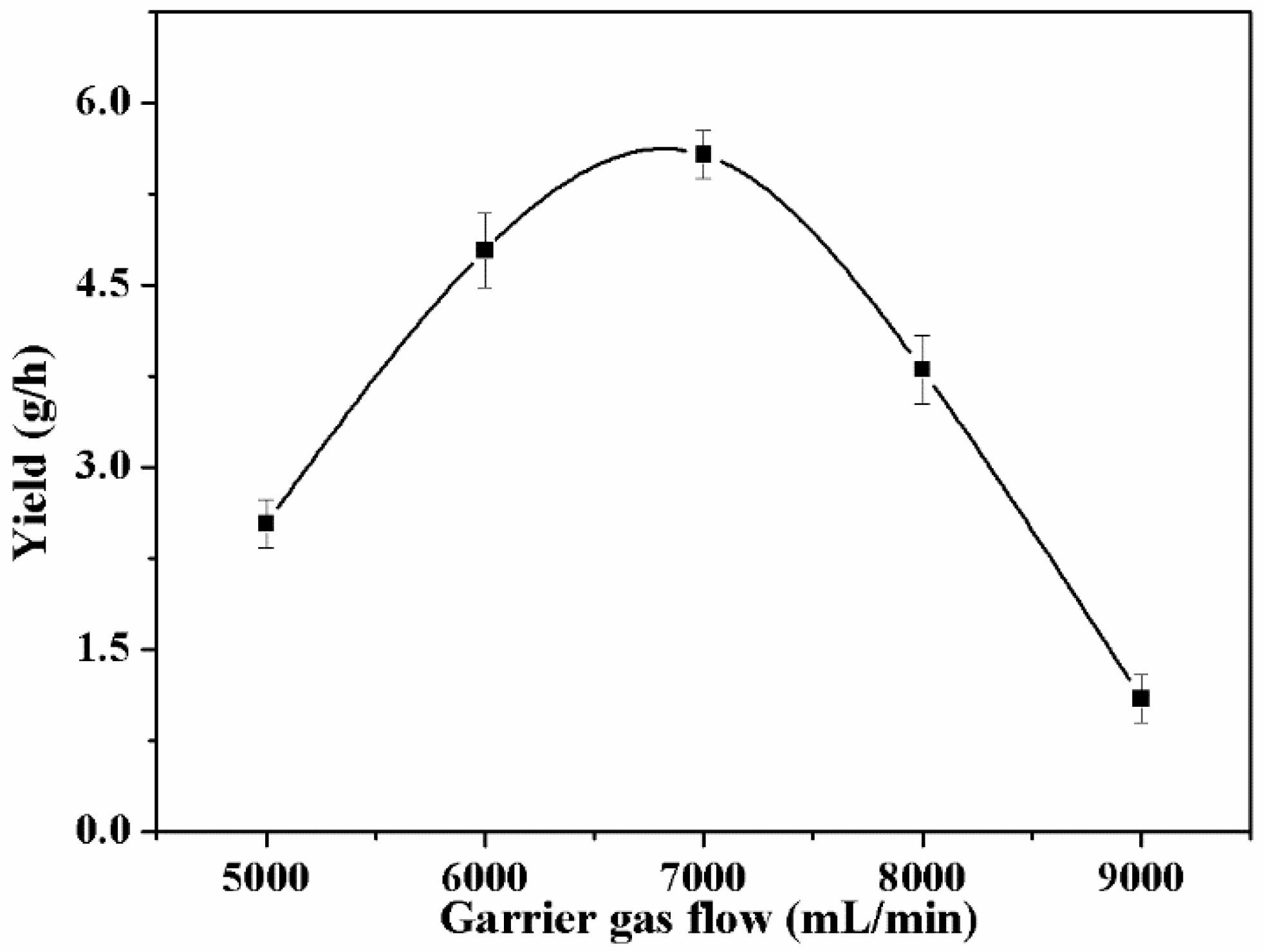

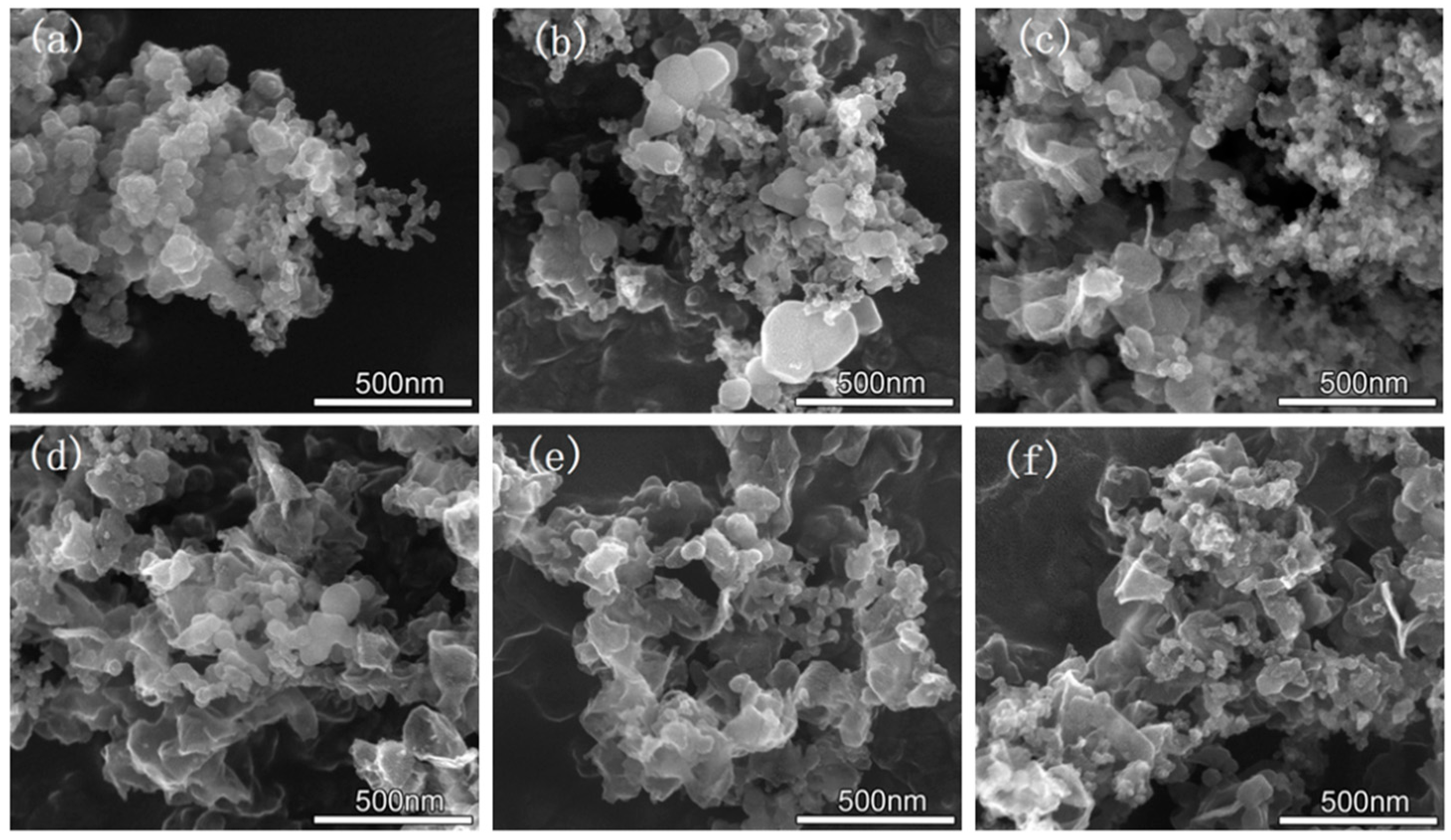
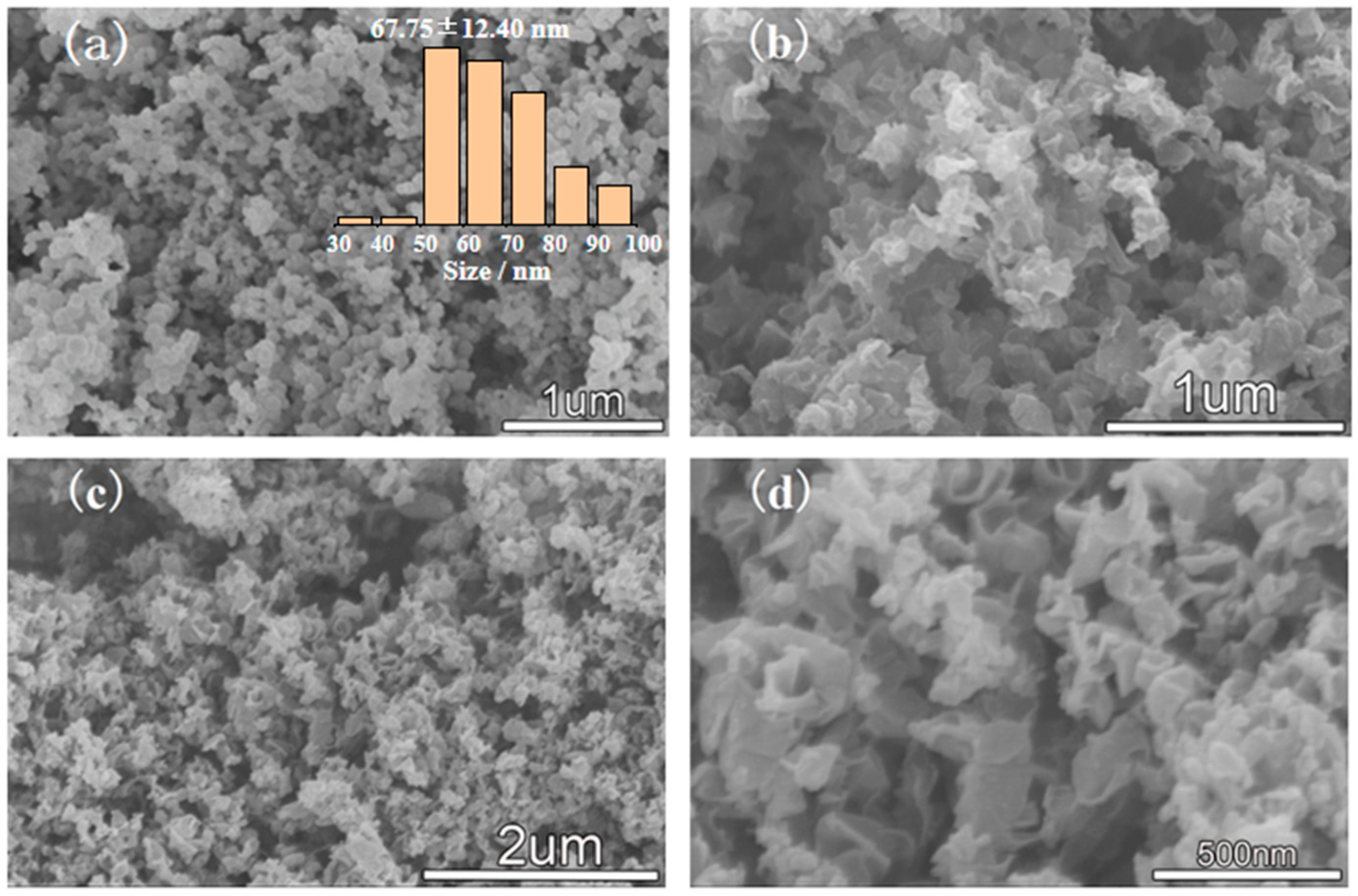
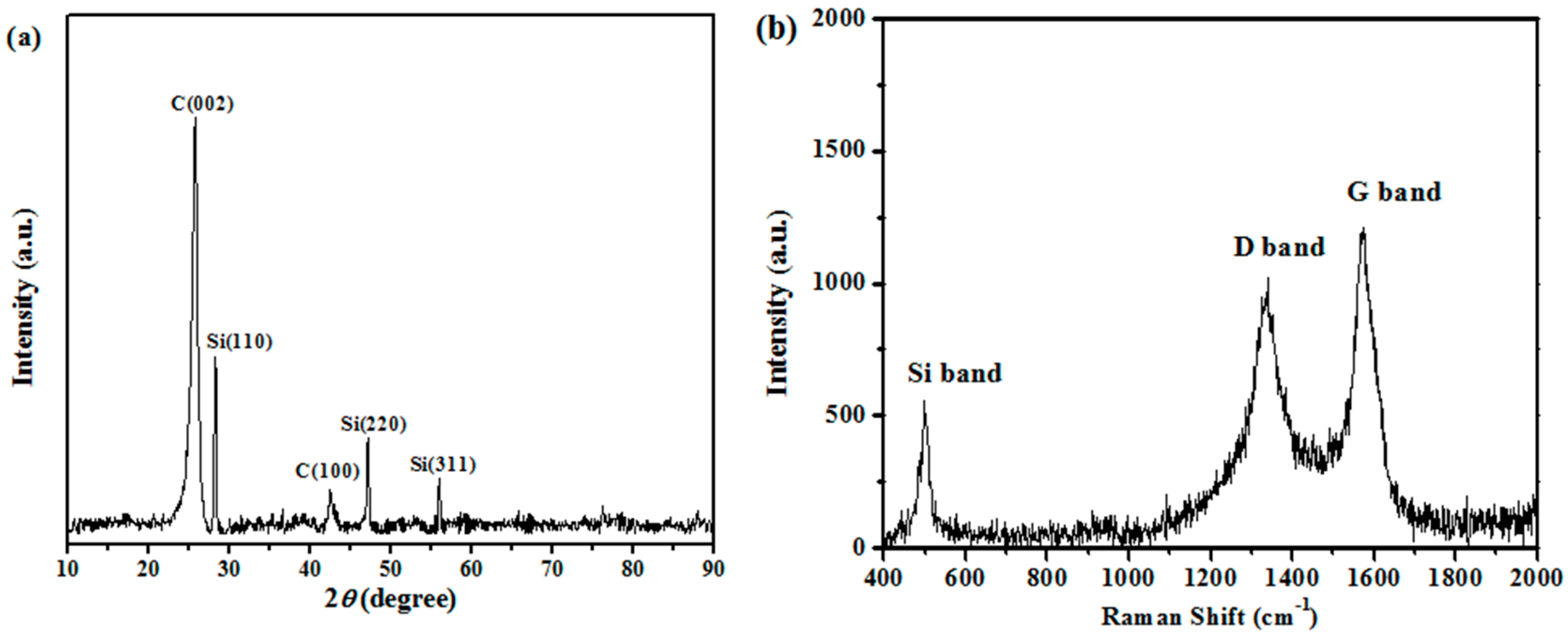
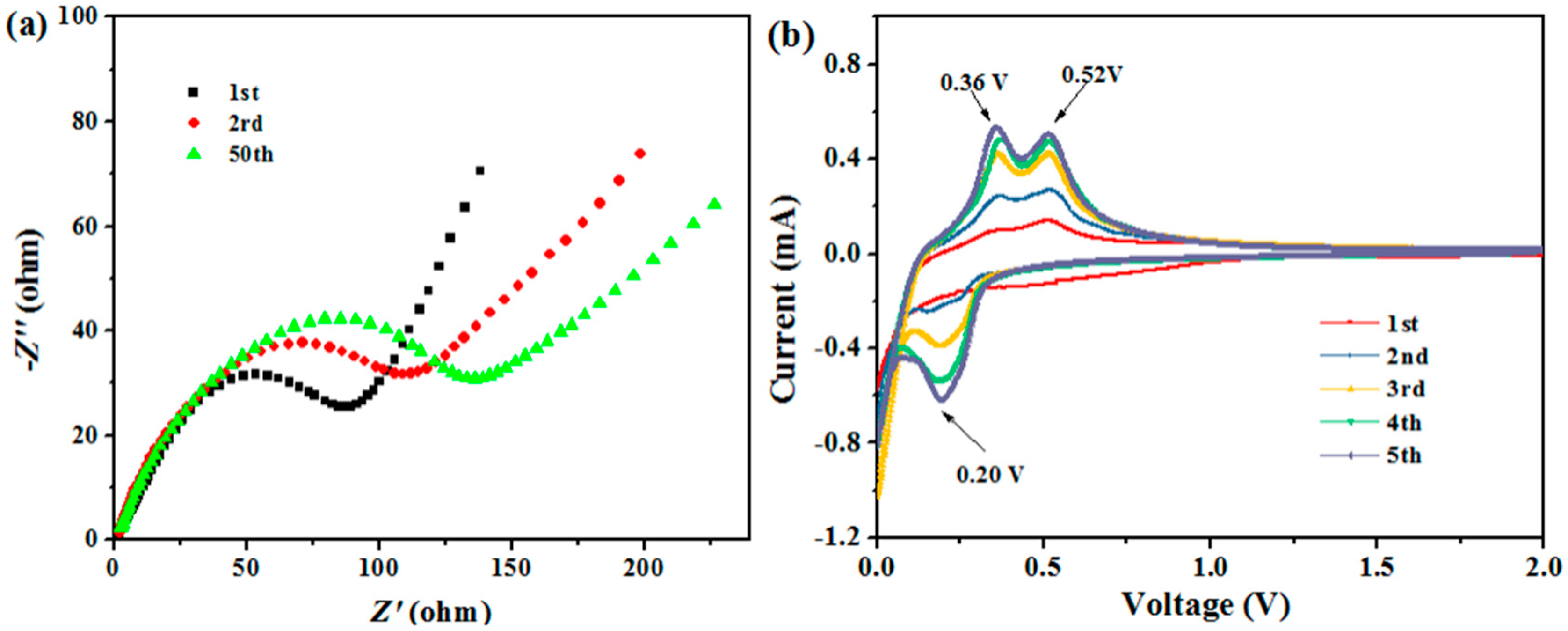
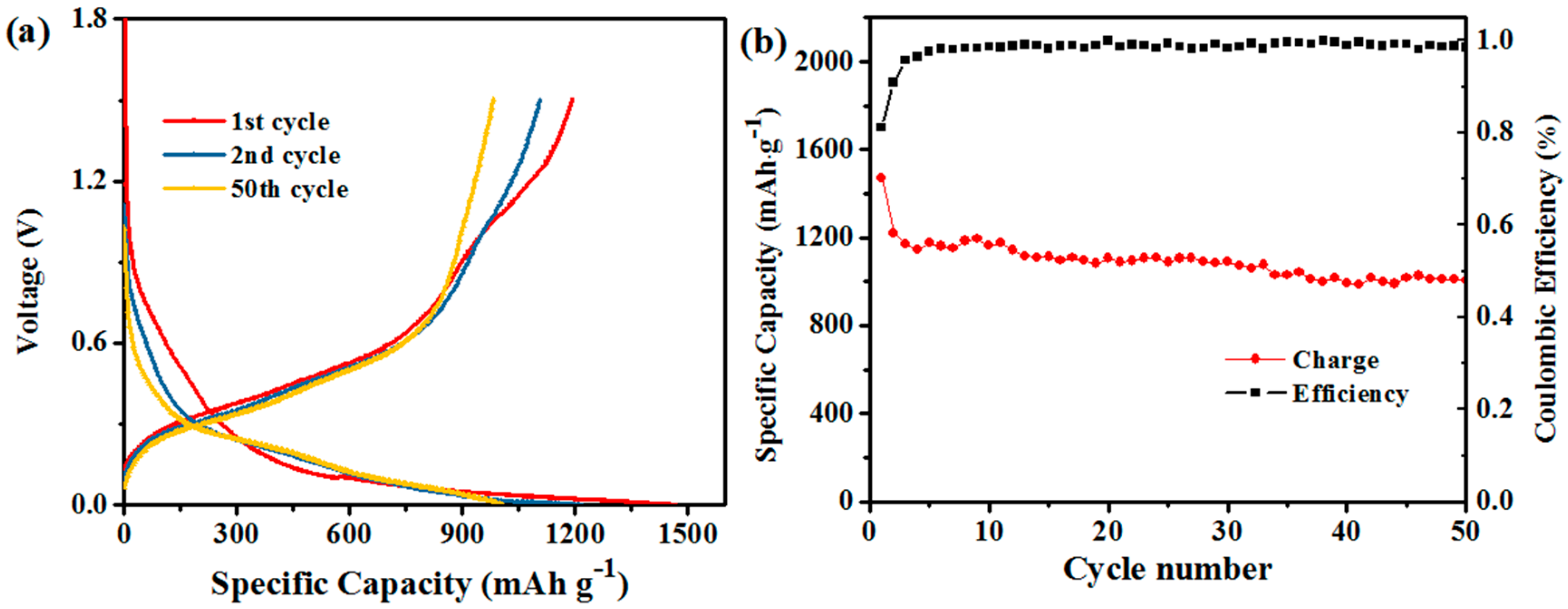
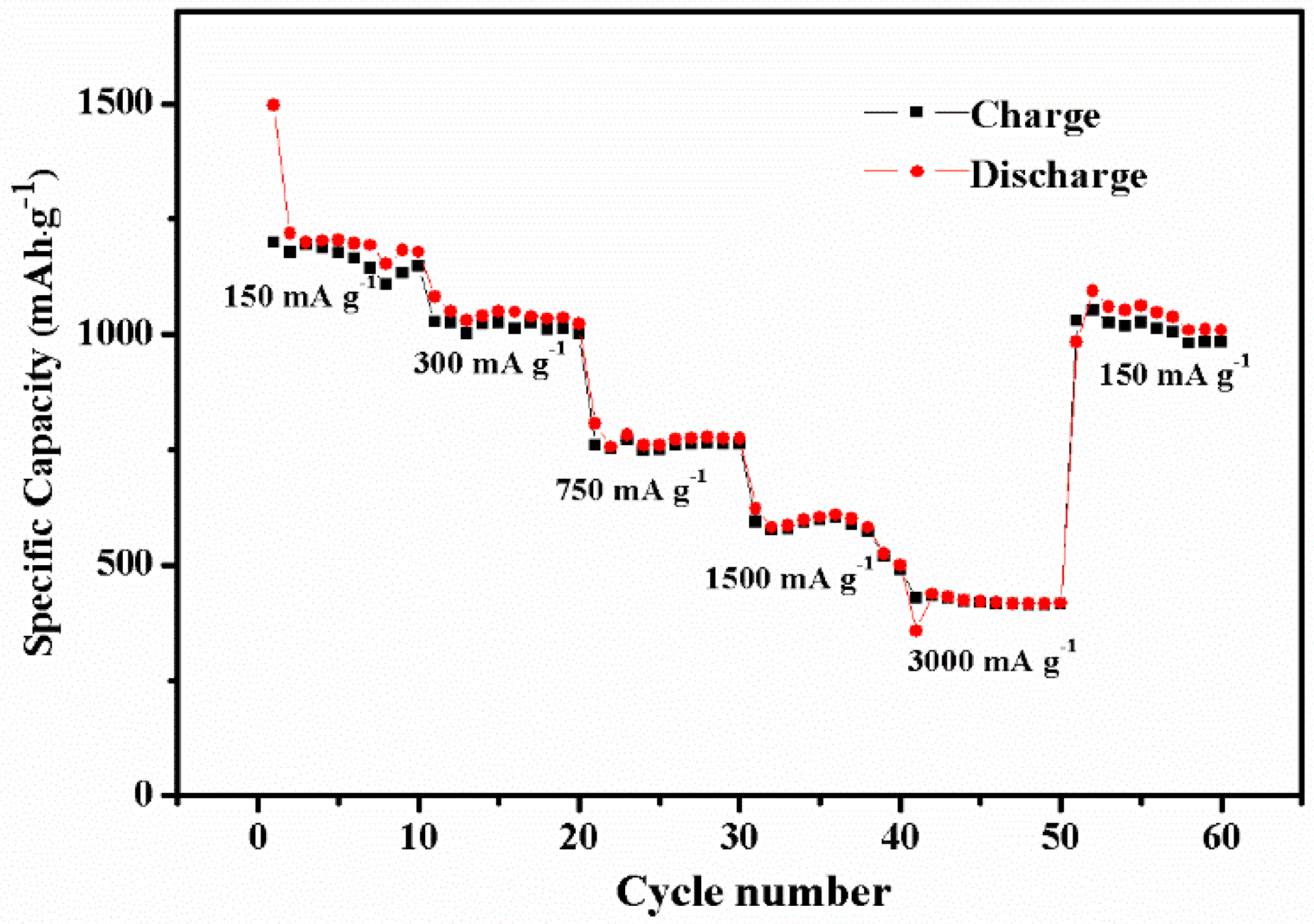
© 2020 by the authors. Licensee MDPI, Basel, Switzerland. This article is an open access article distributed under the terms and conditions of the Creative Commons Attribution (CC BY) license (http://creativecommons.org/licenses/by/4.0/).
Share and Cite
Wang, F.; Gao, M.; Hong, R.; Lu, X. Magnetoelectric Plasma Preparation of Silicon-Carbon Nanocomposite as Anode Material for Lithium Ion Batteries. Appl. Sci. 2020, 10, 2672. https://doi.org/10.3390/app10082672
Wang F, Gao M, Hong R, Lu X. Magnetoelectric Plasma Preparation of Silicon-Carbon Nanocomposite as Anode Material for Lithium Ion Batteries. Applied Sciences. 2020; 10(8):2672. https://doi.org/10.3390/app10082672
Chicago/Turabian StyleWang, Fangfang, Maochuan Gao, Ruoyu Hong, and Xuesong Lu. 2020. "Magnetoelectric Plasma Preparation of Silicon-Carbon Nanocomposite as Anode Material for Lithium Ion Batteries" Applied Sciences 10, no. 8: 2672. https://doi.org/10.3390/app10082672
APA StyleWang, F., Gao, M., Hong, R., & Lu, X. (2020). Magnetoelectric Plasma Preparation of Silicon-Carbon Nanocomposite as Anode Material for Lithium Ion Batteries. Applied Sciences, 10(8), 2672. https://doi.org/10.3390/app10082672





